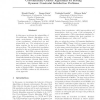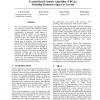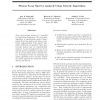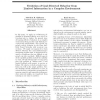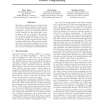GECCO
1999
Springer
14 years 3 months ago
1999
Springer
This paper describes the application of an arti cial immune system,
AIS
, model to a scheduling application, in which sudden changes in the scheduling environment require the rap...
GECCO
1999
Springer
14 years 3 months ago
1999
Springer
From the user’s point of view, setting the parameters of a genetic algorithm (GA) is far from a trivial task. Moreover, the user is typically not interested in population sizes,...
GECCO
1999
Springer
14 years 3 months ago
1999
Springer
In this paper, we discuss the adaptability of Coevolutionary Genetic Algorithms on dynamic environments. Our CGA consists of two populations: solution-level one and schema-level o...
GECCO
1999
Springer
14 years 3 months ago
1999
Springer
The Terrain-Based Genetic Algorithm (TBGA) is a self-tuning version of the traditional Cellular Genetic Algorithm (CGA). In a TBGA, various combinations of parameter values appear...
GECCO
1999
Springer
14 years 3 months ago
1999
Springer
X-ray spectroscopic analysis is a powerful tool for plasma diagnostics. We use genetic algorithms to automatically analyze experimental X-ray line spectra and discuss a particular...
GECCO
1999
Springer
14 years 3 months ago
1999
Springer
GECCO
1999
Springer
14 years 3 months ago
1999
Springer
In this paper, we apply an evolutionary algorithm to learning behavior on a novel, interesting task to explore the general issue of learning e ective behaviors in a complex enviro...
GECCO
1999
Springer
14 years 3 months ago
1999
Springer
Top-down or analytical provers based on the connection tableau calculus are rather powerful, yet have notable shortcomings regarding redundancy control. A well-known and successfu...
GECCO
1999
Springer
14 years 3 months ago
1999
Springer
In genetic programming a general consensus is that the population should be as large as practically possible or sensible. In this paper we examine a batch of problems of combinato...
GECCO
1999
Springer
14 years 3 months ago
1999
Springer
In recent years, the genetic programming crossover operator has been criticized on both theoretical and empirical grounds. This paper introduces a new crossover operator for linea...

